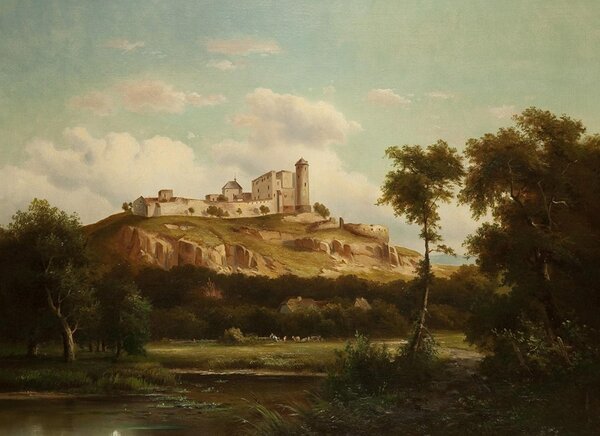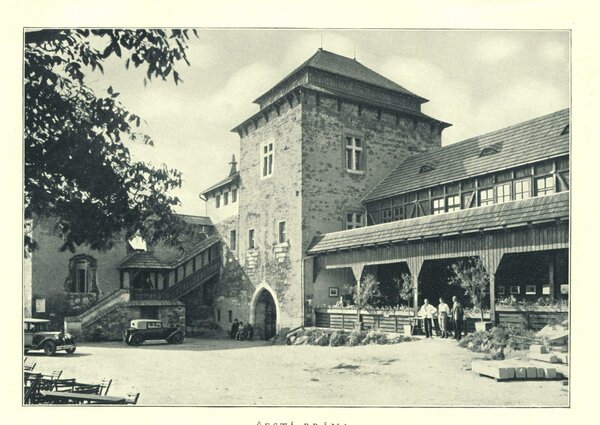History
Kuněticka Hora Castle includes the remnants of the castle buildings of the mid-14th century, and elements from Hussite times, when the castle was important base for Diviš Bořek of Miletinek, are also preserved. A key period is the turn of the 15th and 16th centuries, when the complex was rebuilt by the lords of Pernštejn into a massive twin-towered castle, with an extraordinary fortification system. The Iron Mountains, Eagle Mountains and the Krkonoše mountains can be seen from the Castle Tower. Visitors can visit both permanent and seasonal exhibitions, as well as archeological finds in the castle cellars. There is also a Knights' Hall, an exhibition on the development of the judiciary, an exhibition on par force hunting, an armoury, an exhibition of old prints of the castle, a large floor map of the Pernštejn fish ponds, a 16th century model of the castle, as well as the Chapel of St. Catherine. There are archery facilities and game preserve with deer across the road. The tour of the castle is independent, with optional interpretations that families with children will especially appreciate. In front of the castle there is the wooden cottage of the coalman Věňava, freely accessible to children and a cave can be found in the palace, inhabited by the biggest dragon from the domestic castles. Kunětice Hora has many cultural events every year - music festivals, fairs, grape harvests, open-air theatre performances, concerts, film screenings etc.



Kunětická hora is a dominant point in the Polabí Region (the Elbe Basin) in eastern Bohemia. Due to its silhouette and massive presence in the landscape, it was populated in the prehistoric times already. The settlement of the Middle and Late Bronze Age is well documented, as well as Early Iron Age. The original conic shape of the hill was disrupted over the centuries by stone mining, and in the Middle Ages, the stone castle was added to the silhouette.
Based on the archaeological research, the large castle was standing on Kunětická hora as early as the 2nd half of the 14th century. The castle area included a palace and a prism-shaped tower, then inhabited, in the western part. Given the size of the area, we can’t rule out the idea that the castle was the royal property. No written records of the castle were found.
Kunětická hora became rather well known during the Hussite wars. Since 1421, it was one of the important strategic strongholds of the Hussites. After the conquest of the Opatovice Monastery, the castle was taken by the Hussite commander Diviš Bořek of Miletínek, an able strategist, formerly a radical Orebite, who later joined the moderate faction, and is primarily famous as the victorious leader of the Bohemian League in the Battle of Lipany. Until 1423, he rebuilt Kunětická hora into the typical design of a Hussite castle, with large and well fortified front area used as a winter camp for the troops. After the death of Diviš Bořek in 1437, the vast domain gradually broke up. Kunětická hora was inherited by Soběslav Mrzák of Miletínek, a loyal sideman of King George Podiebrad, who eventually received the castle after 1464. The Hussite King had three sons, and after 1471, Kunětická hora was inherited by one of them, Henry the Elder. During the twenty years of his reign, no big financial successes occurred, and the villages in the domain of Pardubice and Kunětická hora were gradually sold until 1491, when Henry sold the castle together with Pardubice and surrounding land to William of Pernstein.
During the reign of William and his sons Adalbert and John between 1491 and 1548, the major reconstruction of the castle occurred. In several stages of rebuilding, the residential parts of the castle gradually turned into a chateau. The courtyard with the cylindrical tower was fitted with a portal built in 1509, an important proof of the early Pernstein renaissance. For the era of William of Pernstein, the late Gothic style was typical. It could be seen in the vaults of the Knight Hall on the ground floor, in the new Chapel of St. Catherine, in the southern wing and in the tower. During the reign of William and his sons, main halls on the first and second floor of the Southern and Western wing were built, as well as representative halls of the northern wing, with large windows to let enough light in. The importance of the castle in the Pernstein era was proven by the visit of King Ladislaus Jagiello, during which Adalbert and John were knighted (July 1497). The palace was separated from the courtyard by a deep trench with a drawbridge.
Kunětická hora has an outstanding place in the history of the castle architecture due to the fortification system that used large bulwarks and rondelets. Of the latter, only two have remained; the southwestern one was destroyed due to stone mining in the past centuries. The defense system also used circular ramparts with trenches, connected to the system of six defense gates on the northern thoroughfare.
In 1560, Jaroslav of Pernstein sold the domain, deep in debt, to the royal chamber. During the Thirty Years War, Kunětická hora had strategic position. However in 1645, the half-empty castle was conquered by the Swedish troops led by General Linhart Torstenson. The castle, plundered and burned down, decayed quickly, and its downfall was accelerated by the mining of the quality stones that lasted until the early 20th century and destroyed the western and southwestern part of the castle. In the end of the 19th, this part collapsed and fell into the mine.
Various efforts to save spectacular ruins in the 19th century failed. In 1917, the Museum Club, based in Pardubice, rented Kunětická hora, and then bought it in 1919. The Kunětice Cooperative was established and started the conservation works in 1920. In 1923, the renovation of the castle started, based on the project by Dušan Jurkovič and architect Pacl. Based on this architectural concept, a famous restaurant was built, with beautiful indoor areas in the western part, now in restoration. The Kunětice Cooperative renewed some areas on the first and second floor of the palace, and placed an exhibition there.
In 1953, the castle was taken over by the government. Then, due to the lack of maintenance and resulting bad conditions, it was closed in the mid-70s.
After necessary repairs of the palace and large archaeological research, the public access was restored in 1993. The repairs haven’t been finished so far. Kunětická hora is an important tourist destination in the region. In the restored indoor areas, several permanent and seasonal exhibitions are installed; also organized are various theatrical, musical and historical events.